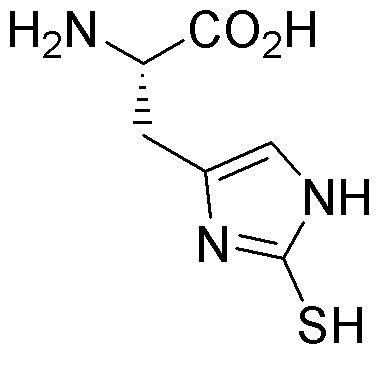2-Mercapto-L-histidine is widely utilized in research focused on
- Antioxidant Applications: This compound acts as a powerful antioxidant, helping to protect cells from oxidative stress. It's particularly valuable in the food industry to enhance the shelf life of products by preventing rancidity.
- Pharmaceutical Development: It plays a crucial role in the formulation of drugs, especially in the development of treatments for conditions like cancer and neurodegenerative diseases, where it can help stabilize active pharmaceutical ingredients.
- Biochemical Research: Researchers use it in studies related to enzyme activity and protein interactions, providing insights into cellular processes and potential therapeutic targets.
- Metal Ion Chelation: The compound is effective in chelating metal ions, making it useful in environmental applications to remove heavy metals from contaminated water sources.
- Cosmetic Formulations: Its antioxidant properties make it a valuable ingredient in skincare products, helping to protect the skin from damage caused by free radicals and promoting a healthier appearance.
General Information
Properties
Safety and Regulations
Applications
2-Mercapto-L-histidine is widely utilized in research focused on
- Antioxidant Applications: This compound acts as a powerful antioxidant, helping to protect cells from oxidative stress. It's particularly valuable in the food industry to enhance the shelf life of products by preventing rancidity.
- Pharmaceutical Development: It plays a crucial role in the formulation of drugs, especially in the development of treatments for conditions like cancer and neurodegenerative diseases, where it can help stabilize active pharmaceutical ingredients.
- Biochemical Research: Researchers use it in studies related to enzyme activity and protein interactions, providing insights into cellular processes and potential therapeutic targets.
- Metal Ion Chelation: The compound is effective in chelating metal ions, making it useful in environmental applications to remove heavy metals from contaminated water sources.
- Cosmetic Formulations: Its antioxidant properties make it a valuable ingredient in skincare products, helping to protect the skin from damage caused by free radicals and promoting a healthier appearance.
Documents
Safety Data Sheets (SDS)
The SDS provides comprehensive safety information on handling, storage, and disposal of the product.
Product Specification (PS)
The PS provides a comprehensive breakdown of the product’s properties, including chemical composition, physical state, purity, and storage requirements. It also details acceptable quality ranges and the product's intended applications.
Certificates of Analysis (COA)
Search for Certificates of Analysis (COA) by entering the products Lot Number. Lot and Batch Numbers can be found on a product’s label following the words ‘Lot’ or ‘Batch’.
Numéro de catalogue
Numéro de lot/série
Certificates Of Origin (COO)
This COO confirms the country where the product was manufactured, and also details the materials and components used in it and whether it is derived from natural, synthetic, or other specific sources. This certificate may be required for customs, trade, and regulatory compliance.
Numéro de catalogue
Numéro de lot/série
Safety Data Sheets (SDS)
The SDS provides comprehensive safety information on handling, storage, and disposal of the product.
DownloadProduct Specification (PS)
The PS provides a comprehensive breakdown of the product’s properties, including chemical composition, physical state, purity, and storage requirements. It also details acceptable quality ranges and the product's intended applications.
DownloadCertificates of Analysis (COA)
Search for Certificates of Analysis (COA) by entering the products Lot Number. Lot and Batch Numbers can be found on a product’s label following the words ‘Lot’ or ‘Batch’.
Numéro de catalogue
Numéro de lot/série
Certificates Of Origin (COO)
This COO confirms the country where the product was manufactured, and also details the materials and components used in it and whether it is derived from natural, synthetic, or other specific sources. This certificate may be required for customs, trade, and regulatory compliance.


